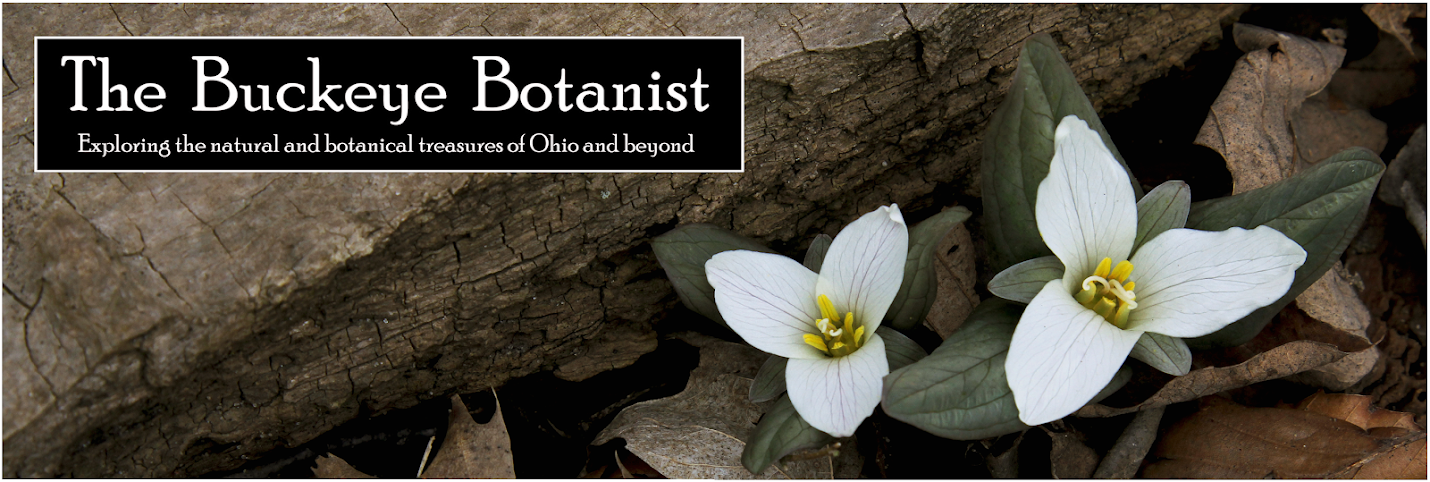 |
| Scioto Brush Creek flowing through wild and rural Scioto county |
In the rolling, forested hills and deep, steamy valleys of Scioto county in extreme southern Ohio flows arguably our state's most pristine and high-quality waterway: Scioto Brush Creek. Its waters and riparian habitat is home to dozens of rare species of flora and fauna such as some critically endangered species of freshwater mussels and the only site in the state for the endangered southern monkshood (Aconitum uncinatum). In fact, this precious aquatic ecosystem is one of the few remaining in Ohio with breeding populations of the muskellunge (musky) and the extraordinary hellbender (our continent's largest salamander at nearly three feet long!). This intact diversity is largely due to over 80% of its entire watershed still being forested and nearly unblemished.
 |
| Peering through the dense vegetation of the gravelbar |
A couple weekends back your blogger finally got the opportunity to explore a particular stretch of the stream with a very specific type of habitat and plant on the menu. On a gravelbar jutting out into the dirvese waters of the creek lives one of our state's rarest of vascular plants. The dense thicket of vegetation certainly did a good job of concealing it but I knew with enough luck and tenacity the object of my quest couldn't hide forever.
 |
| Appalachian Spiraea (Spiraea virginiana) |
Peering through the tangle of river birch, sycamore, and buttonbush finally paid off as my eyes were greeted with the majestic off-white blossoms of the Appalachian spiraea (Spiraea virginiana). It's not too hard to see the relation to our other Spiraea species (S. alba and S. tomentosa respectively) by the showy clusters of flowers with its conspicuous protruding stamens. Unlike the other two more common species with their elongated, wand-like inflorescence, the Appalachian spiraea has a flat-topped corymb that is the envy and desire of countless bee, beetle, and fly pollinators.
 |
| Appalachian Spiraea (Spiraea virginiana) |
Perhaps the most interesting thing about the Appalachian spiraea is the dynamic habitat type it has evolved to occupy and utilize. While most other plants tend to shy away from extreme episodes of disturbance and erosion, this peculiar plant has learned to cope and thrive with its destructive powers. Appalachian spiraea grows in the specialized niche of gravelbars and scour-zones of mid-sized streams and waterways that are seasonally flooded and swept clean of competing vegetation. Its underground root system is comprised of a fibrous root mass containing lateral rhizomes that allow the plant to send up shoots after a flood/erosion event and quickly bounce back.
 |
| North American distribution of Spiraea virginiana (courtesy BONAP) |
Not only is the Appalachian spiraea very rare in our state but over much of its range as well. This global rarity combined with dwindling habitat availability has earned it the right to be recognized as a federally threatened species; one of six Ohio species listed at the federal level. It is still extant in seven states throughout the Appalachians and Cumberland plateau with historical records in Pennsylvania and Alabama. Here in Ohio, it is only known to occur in a handful of locations along the banks of Scioto Brush Creek and that's it statewide. Its presence here is owed to the extinct Teays River that flowed northwest up from the Virginians and into Ohio; bringing with it the Appalachian spiraea and other botanical rarities such as the flame azalea (Rhododendron calendulaceum) and Canby's mountain lover (Paxistima canbyi).
 |
| Appalachian spiraea setting to fruit |
In addition to its restricted geographical range and rare occurrences, the Appalachian spiraea is fighting a losing battle genetically as well. Today there are less than 30 total genotypes known; meaning there are less than 30 individual sets of genes for this species. All the remaining plants belong to one of those 20-some individuals. This has resulted in very poor seed production and little to no true sexual reproduction among populations. Fortunately, their specialized trait of vegetative cloning is a saving grace and allows the species to continue to persist and potentially spread throughout its watershed post flooding events.
 |
| Appalachian Spiraea (Spiraea virginiana) |
In regards to its uphill battle for survival and the odds stacked against it, I found myself overly pleased to be in its presence and witness to its stunning blooms concealed among thickening mass of shrubs and maturing trees. How lucky is the Buckeye state to claim something so scarce and beautiful to her soils; brought here by ancient forces long extinct but hardly forgotten. The Appalachian spiraea has called the scoured banks and gravelbars of Scioto Brush Creek home for thousands of years before its discovery by man and with any luck it will continue to call this remarkable waterway home for millennia to come.































